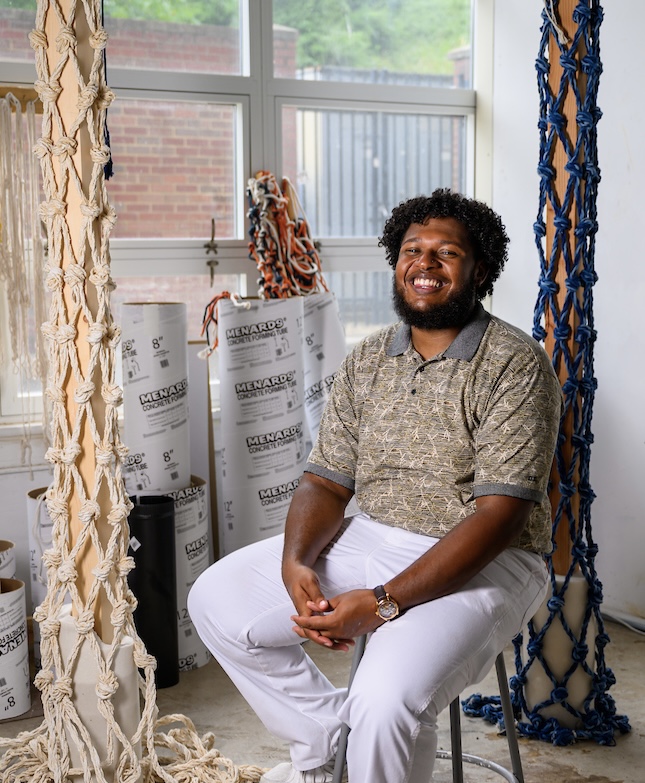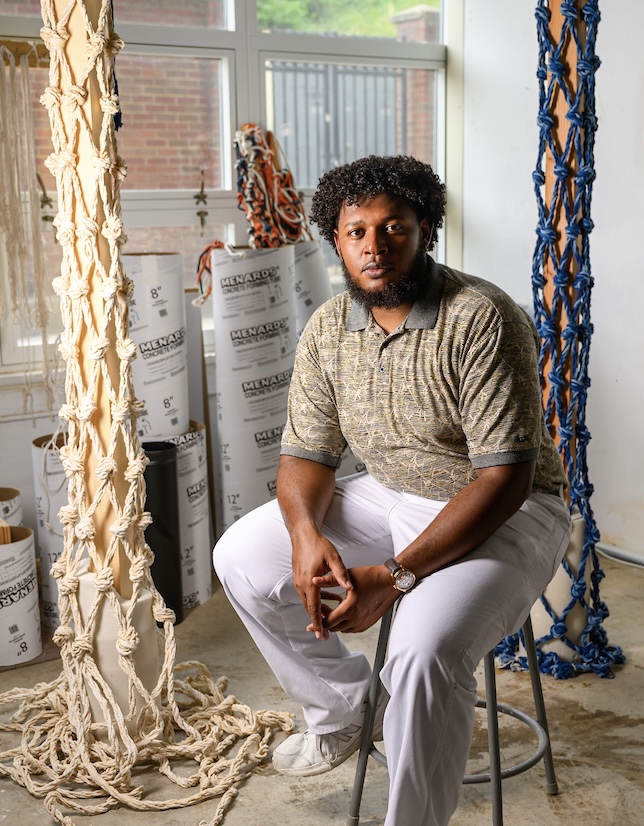Ray Perez, a graduate student in the Sculpture + Expanded Practice program at Ohio University, has been awarded the 2024 Outstanding Student Achievement in Contemporary Sculpture Award by the International Sculpture Center . This esteemed recognition celebrates Perez's innovative approach to sculpture and his profound exploration of identity and societal themes. As the third Ohio University student to receive this honor in the past five years, Perez's achievement highlights the university's commitment to nurturing exceptional talent in the arts. In this Q&A, Perez reflects on his artistic journey, the inspiration behind his award-winning work, and his aspirations for the future.
Describe your background and what brought you to Ohio University.
I grew up in Parma, Ohio, and I’ve wanted to be an artist for as long as I can remember. In high school, I took every art class available and completed a two-year visual communications vocational program that solidified my path in the visual arts. After earning my BFA in Sculpture + Expanded Practices from Ohio University in 2016, returning for my MFA felt like the right decision. This program offers a unique environment that tests your limits—balancing intense work with the realities of life outside the studio. It’s not easy, but the challenges here sharpen your adaptability and problem-solving skills. It’s a space that encourages growth and has prepared me to step into the broader art world with confidence and resilience. I’m in the final year of a three-year program, working toward my MFA.
How has OHIO supported your artistic journey?
Several factors were integral to my time here, but first and foremost, any program is only as strong as its faculty. I’ve had the privilege of working with a phenomenal thesis committee—Duane McDiarmid, Kate Hampel, Jennie Klein, and John Sabraw. Their guidance has been invaluable in shaping my research and pushing my practice forward. I see this award as an affirmation of both my work and their pedagogy. Their support allowed me to develop ideas in ways I couldn’t have done alone, and for that, I’m incredibly grateful.
How did you feel about winning this award?
I felt a deep sense of gratitude and affirmation—not just of the work itself but of the research and exploration that underpins it. It’s encouraging to see that the ideas I’ve been investigating and the risks I’ve taken with my practice are resonating. That kind of affirmation motivates me to keep pushing forward.
Describe your award-winning piece and its inspiration.
This piece began as an exploration of what kind of monument could stand in for my body at this point in my life. I landed on the metaphor of a lighthouse—a beacon that guides but also repels, as getting too close is perceived as 'dangerous.' This duality captured how I felt: seeking connection yet needing protection. As the piece evolved, the lighthouse came to represent the experiences of Black men navigating complex societal structures.
While I don’t claim to speak for all Black men, I believe cultural and systemic barriers create a unique set of challenges for us. This work speaks from that voice, while also addressing more universal feelings of tension and distance. My experience as the only out queer Black person in my program and the challenges of connecting with other Black men in this space further shaped the work. Institutional barriers limit enrollment, and queer stigma persists within male communities, which adds layers to that tension.
The plyed rope became central to the piece, symbolizing how a single strand grows stronger when woven together with others, much like community. That idea extended into net-making. The net can capture, protect, or, in this instance, signal. I’m not entirely sure who that signal is meant for yet, but the ambiguity reflects the tension between wanting connection and not knowing who will receive it.

Ray Perez poses with his award-winning sculpture. This piece symbolizes the duality of guidance and danger, reflecting Perez’s personal journey and the broader experiences of Black men navigating societal complexities.

The lighthouse metaphor captures the tension between seeking connection and maintaining protection, while the intricate net-making element represents community strength and resilience.
What is your creative process like?
Reading is an integral part of my studio practice. I often find myself balancing time in the studio with time immersed in research. It’s important that my work be informed by both lived experience and theory—these two elements help me approach the work from both emotional and intellectual perspectives. But honestly, a lot of times when I go to the studio, I don’t know what I’m doing at first. I know that’s not the neat, professional answer people expect, but it’s the reality of my process. I usually start by tinkering—letting my hands lead before any clear idea forms.
During that time, I think about passages from my readings or the people who represent certain ideas, and I try to translate them into something visual. My process isn’t linear or rigidly planned; it’s more of a search for meaning that emerges as I work with materials. That balance between making and reflecting is central to what I do.
How do you hope this award will impact your career?
I hope this award serves as a steppingstone, helping me connect with a wider network of artists and creative people. Recognition like this can open opportunities for collaboration and dialogue, which are essential for growth as an artist. I’m looking forward to where these new connections might lead.
Is there anything you wish you’d known earlier in your career?
I wish I had realized earlier that 'failure' is a wonderful part of the process. Being wrong or not knowing what I’m doing has given me the most room to grow, learn, and evolve as an artist. Embracing that uncertainty has been key to my development, and I wish I had been more comfortable with it from the start.
What is failing? It’s usually just things not going the way we intended, but that doesn’t mean the effort was wasted.
What are your future plans?
Looking ahead, I want to continue my research and keep making and sharing my work. I’m open to teaching and working in higher education, but my ultimate goal is to be an established artist, whatever form that takes. I see my practice expanding, allowing me to engage deeply with my ideas while also finding platforms to share that work through exhibitions, residencies, and other creative opportunities.
What advice would you give to aspiring artists?
I always tell my students that they’re all made in their own image. They’re not supposed to be doing the same thing as everyone else. Each of us has unique skillsets and perspectives, and those differences allow your deeper, resonant voice to come forward. The key is to authentically engage with an idea or concept until you’ve resolved it for yourself. When you’re truly invested in your research, you’ll eventually cross paths with people who are just as interested in what you’re talking about as you are. Recognition comes from staying true to your process and your voice.


